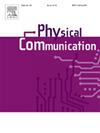MDRD-Based Channel State Information Acquisition Scheme for Intelligent Reflecting Surface-Aided Wireless Communication Systems
IF 2
4区 计算机科学
Q3 ENGINEERING, ELECTRICAL & ELECTRONIC
引用次数: 0
Abstract
The performance gains of intelligent reflecting surface (IRS)-aided wireless communication systems are highly dependent on the precise acquisition of channel state information (CSI). In IRS-aided wireless communication systems that employ model-driven CSI acquisition schemes, it is typically difficult to adapt to changes in the environment or user positions. The inadequate accuracy of CSI acquisition severely restricts the beamforming gains that IRS can bring to the system. Benefiting from minimal reliance on channel models and effective online estimation, data-driven CSI acquisition approaches are emerging as a research hotspot in IRS-aided wireless communication systems. However, in IRS-aided wireless communication systems using data-driven CSI acquisition schemes, a standard neural network is usually adopted, rather than constructing specialized architectures tailored to data characteristics, leaving room for further performance improvements. For obtaining more accurate real-time CSI and maximizing the performance gains brought by IRS, the CSI acquisition challenge is modelled as a denoising task, and a multi-scale dense residual denoising convolutional neural network (MDRD)-based denoising scheme is introduced in this paper. The scheme repeatedly adopts denoising blocks based on residual structures with short-skip connections and multi-scale convolutional kernels for network construction. The MDRD denoising model, with parameters set during offline training, is subsequently applied in the online application phase for CSI acquisition. Simulation results indicate that the MDRD-based CSI acquisition scheme achieves a relative enhancement of at least 36.2 % in CSI estimation accuracy at the cost of an almost negligible performance loss in denoising speed, thereby effectively balancing the accuracy and real-time capabilities of CSI acquisition.
基于mdrd的智能反射地面辅助无线通信系统信道状态信息获取方案
智能反射面(IRS)辅助无线通信系统的性能提升高度依赖于信道状态信息(CSI)的精确获取。在采用模型驱动CSI采集方案的irs辅助无线通信系统中,通常难以适应环境或用户位置的变化。CSI采集精度的不足严重限制了IRS给系统带来的波束形成增益。数据驱动的CSI采集方法得益于对信道模型的最小依赖和有效的在线估计,正在成为irs辅助无线通信系统的研究热点。然而,在使用数据驱动CSI采集方案的irs辅助无线通信系统中,通常采用标准的神经网络,而不是根据数据特征构建专门的体系结构,从而为进一步的性能改进留下了空间。为了获得更精确的实时CSI,最大限度地提高IRS带来的性能收益,本文将CSI采集挑战建模为去噪任务,提出了一种基于多尺度密集残差去噪卷积神经网络(MDRD)的去噪方案。该方案反复采用基于短跳连接残差结构的去噪块和多尺度卷积核进行网络构建。在离线训练期间设置参数的MDRD去噪模型随后应用于在线应用阶段的CSI采集。仿真结果表明,基于mdrd的CSI采集方案在去噪速度上的性能损失几乎可以忽略不计的情况下,CSI估计精度相对提高了至少36.2%,从而有效地平衡了CSI采集的准确性和实时性。
本文章由计算机程序翻译,如有差异,请以英文原文为准。
求助全文
约1分钟内获得全文
求助全文
来源期刊

Physical Communication
ENGINEERING, ELECTRICAL & ELECTRONICTELECO-TELECOMMUNICATIONS
CiteScore
5.00
自引率
9.10%
发文量
212
审稿时长
55 days
期刊介绍:
PHYCOM: Physical Communication is an international and archival journal providing complete coverage of all topics of interest to those involved in all aspects of physical layer communications. Theoretical research contributions presenting new techniques, concepts or analyses, applied contributions reporting on experiences and experiments, and tutorials are published.
Topics of interest include but are not limited to:
Physical layer issues of Wireless Local Area Networks, WiMAX, Wireless Mesh Networks, Sensor and Ad Hoc Networks, PCS Systems; Radio access protocols and algorithms for the physical layer; Spread Spectrum Communications; Channel Modeling; Detection and Estimation; Modulation and Coding; Multiplexing and Carrier Techniques; Broadband Wireless Communications; Wireless Personal Communications; Multi-user Detection; Signal Separation and Interference rejection: Multimedia Communications over Wireless; DSP Applications to Wireless Systems; Experimental and Prototype Results; Multiple Access Techniques; Space-time Processing; Synchronization Techniques; Error Control Techniques; Cryptography; Software Radios; Tracking; Resource Allocation and Inference Management; Multi-rate and Multi-carrier Communications; Cross layer Design and Optimization; Propagation and Channel Characterization; OFDM Systems; MIMO Systems; Ultra-Wideband Communications; Cognitive Radio System Architectures; Platforms and Hardware Implementations for the Support of Cognitive, Radio Systems; Cognitive Radio Resource Management and Dynamic Spectrum Sharing.
 求助内容:
求助内容: 应助结果提醒方式:
应助结果提醒方式:


